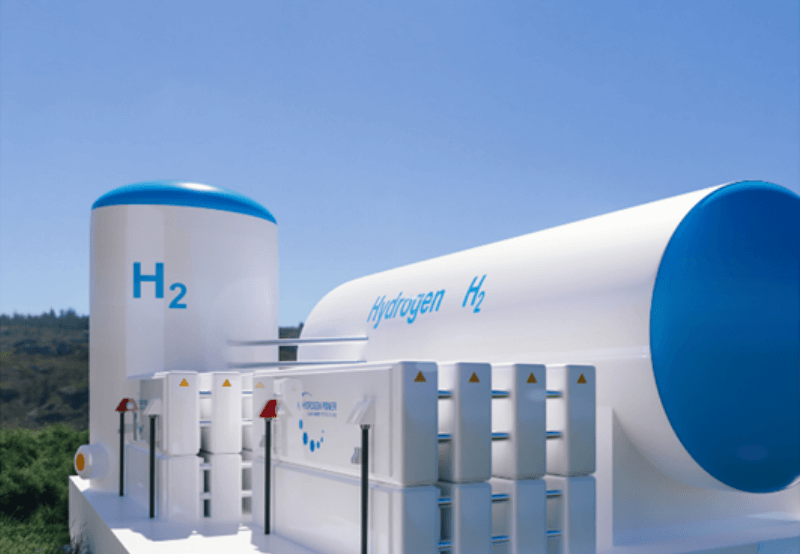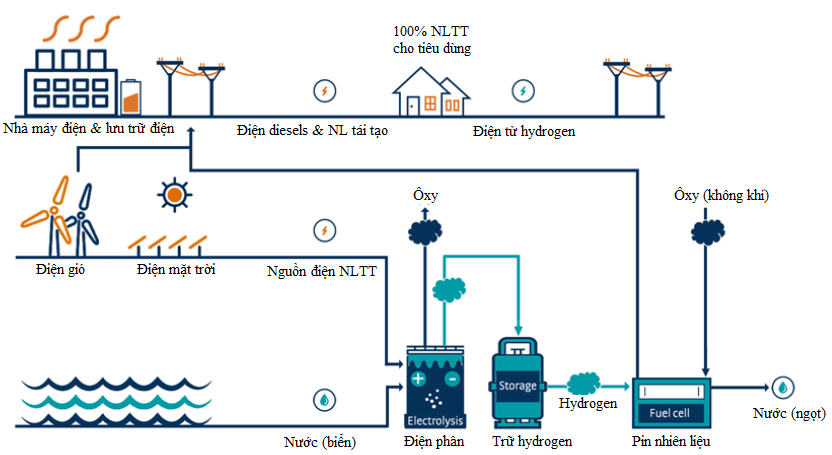Green hydrogen – A clean energy storage solution
As a fuel for many industries, hydrogen has become a pursuit in the energy development strategies of many countries. In particular, green hydrogen is expected to be the key to a zero-carbon economy. It is also an efficient energy storage solution, helping to promote the development of renewable energy sources such as wind power, solar power, etc.
Large reserves, diverse applications
Hydrogen (hydrogen - H2) is a common chemical element, making up about 75% of the total mass of the universe and more than 90% of all atoms. Currently, hydrogen is widely used in chemical industries such as ammonia, methanol, fertilizer production, metallurgical industry, oil refining, semiconductors, cosmetics, etc. In the energy field, hydrogen has can be burned directly in internal combustion engines, replacing natural gas to provide energy for daily civil needs, as fuel for rockets in the space industry and national defense. Hydrogen is also an energy source for fuel cell systems, generating electricity through the electrochemical process. Hydrogen fuel cells have the potential to become a potential fuel source for road, marine, railway, aviation vehicles...; will play the leading role of the hydrogen economy in the future.

Hydro là nguồn năng lượng thứ cấp, được tạo ra từ một nguồn sơ cấp ban đầu như nước hoặc các hợp chất hydrocarbon khác nên có trữ lượng rất lớn. Có nhiều phương pháp để sản xuất hydro. Chẳng hạn, phương pháp nhiệt hóa các loại nhiên liệu hydrocarbon (như metan, dầu…), sử dụng công nghệ nhiệt hóa khí thiên nhiên bằng hơi nước, khí hóa hydrocarbon nặng gồm dầu mỏ và than đá ở nhiệt độ cao trong điều kiện thiếu oxy… Tuy nhiên, phương pháp này gây ra phát thải khí nhà kính CO2; hydro được tạo ra bằng phương pháp này được gọi là hydro xám (grey hydrogen). Hydro được sản xuất bằng phương pháp nhiệt hóa hydrocacbon, kết hợp công nghệ thu gom và lưu trữ CO2 được gọi là hydro lam (blue hydrogen). Hydro còn được sản xuất bằng phương pháp điện phân nước (dùng điện để tách nước thành khí H2 và O2), sử dụng điện năng từ các nguồn năng lượng tái tạo như điện mặt trời, điện gió… Phương pháp này không gây phát thải khí CO2, được đánh giá là công nghệ sạch, bền vững, xu hướng của tương lai. Hydro được sản xuất bằng phương pháp này được gọi là hydro xanh (green hydrogen)
Efficient, long-term energy storage solution
Because electricity is used in the production of hydrogen (by electrolysis of water), it is then generated by electrochemical processes (in fuel cells) or from gas turbines powered by electricity. Hydrogen is an efficient and long-term energy storage method. Hydrogen produced from renewable energy can be considered as a form of stored energy, for use during periods of the night, when there is no wind; Therefore, the development of green hydrogen will also help promote the development of renewable energy and the trend of energy transition. quality towards a zero-carbon economy.

The combination of renewable energy plants (solar power plants, wind power plants, etc.) with green hydrogen production facilities by electrolysis and power plants using fuel cells or hydrogen-powered gas turbines to form an integrated Gas-Electricity system is also a solution to take advantage of both renewable energy and hydrogen as an energy storage system.
Hydrogen technology development trend in the world
Hydrogen is interested in many countries around the world as a clean energy source to replace fossil fuels. Hydrogen is also focused on as an energy storage strategy to fully utilize the benefits of renewable energy, meet the energy transition needs, and solve environmental problems while ensuring security. national energy
In 2020, the European Commission (EC) announced the "New Hydrogen Strategy", lasting from 2020 to 2050, which aims to phase out greenhouse gas emissions in all sectors across the European Union, while further developing reusable hydrogen. Currently, the EU has more than 70 hydrogen research and development projects underway by governments, universities and businesses. Within the EU, Germany is aiming to become the world's leading producer and supplier of hydrogen. In June 2020, with the "National Hydrogen Strategy", the German Cabinet agreed to spend 9 billion euros ($10.2 billion) to realize this goal. Meanwhile, the French government aims to use 10% of green hydrogen industrially by 2022 and increase to 20-40% by 2027. Romania also sends a strong signal in favor of hydrogen. green by establishing the ROHYDROHUB Center dedicated to research activities in the field of hydrogen
In Asia, Japan is a pioneer in research and technology development and towards a hydrogen economy. Since 1992, Japan has established the International Clean Energy Network using Hydrogen - a program focusing on research and development of hydrogen technologies for 10 years. Since then, Japan has launched many national strategic plans and roadmaps on hydrogen and fuel cells. South Korea also aims to be the world leader in the market share of hydrogen-powered cars and hydrogen fuel cells. The Government of this country has agreed to apply the "Hordy Power Generation System" (HPS) until 2022 in order to systematically disseminate hydrogen fuel cells with a focus on expanding the hydrogen economy.
The current hydrogen technology is facing a number of challenges such as storage infrastructure is limited in capacity, the cost of hydrogen production from electrolysis is still high, transportation is difficult... However, with the investment research and development investment of many governments and businesses, when these challenges are solved, hydrogen will be a promising source of energy, promoting renewable energy and together with renewable energy becoming a major source of energy. energy of the future.